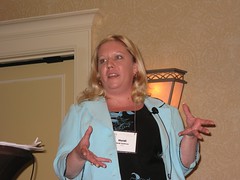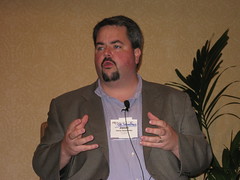This panel at the PRSA Digital Impact Conference includes Heidi Sullivan and Jay Krall of Cision and Jason Falls of Doe Anderson and who writes Social Media Explorer.

Heidi starts out a with a poll: How many comments for media relations? and How many have created a social profile for a client? A small number of hands raise for each question.

Jason: What are three things you want to know?
- Less tools and tactics and more to how you’re applying this, illustrating the value of it
- More about blogger relations
- Strategy and context. Enough about tools. Are blogs for every organization?
My observation is that based on these questions, it seems many of the PR professionals in the audience are not sold on blogs per se, and tools/tactics are premature. They want to know if a blog makes sense or not, does it fit within an overall communications plan.
Social media is about community not an audience.

Ironically, Jay starts out talking about tools. How do you find the right blogs to pitch? You qualify blogs to pitch not by the reader counts, but by how much that blog’s content is shared amongst others.
Process for finding blogs stats with blog search through something like Technorati. Then use traditional metrics like RSS subscribers. Also mentions unique visitors and email subscribers (for blogs that make that kind of information available)
Social metrics let you see whether a blog’s content gets passed around. Examples: BlogPulse, Delicious, Digg, Newsvine, Google blog search, Reddit, Mixx, Tailrank, Technorati, Stumbleupon, etc.
Once you see that a blog is popular amongst these social metrics, you’ll know that blog is worth spending your time on.
Jason mentions that being strategic about reaching out. Blogs may not be the best first content. He mentions Beam Global, owner of Maker’s Mark his client. He’d reach out to forums about new information before going to blogs about bourbon.
Playing by the rules in social communities gives you permission to contribute. Being transparent is what gives you the credibility to participate and share information with the community.
For PR practitioners: How do I determine whay type of involvement I should have with social media?
How does my target market consumer news.
Heidi talks about the importance of psychographics over demographics. Jason follows up with the distinction in psychographics between bourbon and whiskey brands.
Benefits of social media: Social media efforts are supplemental to your regular PR and media relations campaigns. It;s more direct to consumer communications than most PR pros are accustomed to. Social media carries with it an immediacy.
How do you deal with crisis managment when dealing with dissenting bloggers? You need to be involved in the space. Consumers can tell a “troll” versus a legitimate complaint. You need to be transparent, open and honest (easier said then done).
Gina Trapani of Lifehacker started a PR blacklist. It gets mentioned that Gian’s personal email address was listed in the Cision database. Heidi relates a story of how Jason Twittered not hearing back from Cision and how she contacted Jason to answer the questions he had. She was quick to reply to his concerns, honest, apologetic and transparent in Cision’s willingness to correct the problem and serve the PR community.
Jason mentions an event tomorrow 1pm Eastern with Shel Holz and Neville Hobson as well as many others in the PR, media and blog communities to talk about how to best improve communications between media relations and the media. http://www.blogtalkradio.com/fir
Responding quickly and honestly are key for PR and media relations professionals communicating with bloggers. Being a resource to bloggers and reaching out as a “heads up” and not a specific pitch can be very effective.
Find them, read their posts, what they write about, what they care about, and reach out to them in a very personalized way. willvideoforfood.com best blog pitch letter ever. Actually it wasn’t a great pitch because the blog post didn’t mention Jim Beam, more about Jason’s actual pitching skills. Although it does include links to Jim Beam.
Jason says you should ask for opinions and show that you care.
The pitch vs community engagement involves establishing authenticity: Comment, reach out and participate.
Time for Q and A:
Audience: Is there an equivalent measurement you can share with clients that equal to some monetary value
Jason: It depends on what you’re trying to accomplish. If it’s sales, you need to have that in mind from the start. Links need to go to the same landing page designed to convert to a sale. We report buzz factor, talk valiue, PR clippings. Specifics include feedback, inbound links, comments.
You have to get buy in from corp from day one on what the key metrics will be. RSS subscribers, links, and other outcomes.
Audience: Itmsounds like a FT job, but for an organization that has slim resources, how much time should be allocated to blog relations and outreach?
Jason: You want consistent content, once a week.
Heidi: Blogher recently did a study, that people read blogs 4 times a day.
Jason: More active participation will result in an effect more quickly. Allocate a certain about of time per month for creating that month’s editorial calendar.
Audience: My company sells a diverse range of products, How do you decide whether a blog makes sense?
Jason: Where does your audience spend their time?
Jay: Start by evaluating what’s out there. It’s amazing how many blogs there are for every niche.
Jason: Even if there isn’t a blog for your niche, then take the first mover advantage.
Audience: What’s the difference between blogs in general and blogs run by journalists?
Jason: Coordinate with PR to make sure there isn’t any crossover.


